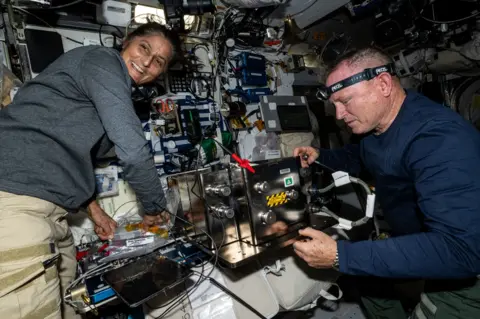 NASA
NASABoeing’s Starliner spacecraft has begun its journey back to Earth, but the astronauts it was supposed to carry are staying at the International Space Station.
The empty spacecraft has switched to autonomous mode and has detached from the orbiting laboratory.
The capsule carrying NASA astronauts Butch Wilmore and Suni Williams encountered technical problems after launch, and it was deemed too risky to bring them home.
They will return aboard the SpaceX Crew Dragon spacecraft, but not until February – extending their stay on the International Space Station from eight days to eight months.
 NASA
NASAStarliner’s return flight will last six hours, using a parachute to slow its descent after re-entering Earth’s atmosphere and landing at White Sands Spaceport in New Mexico on Saturday.
NASA said earlier that Butch and Suni were in good spirits and were in regular contact with their families.
NASA Commercial Crew Program Manager Steve Stitch said at a media briefing that both astronauts are passionate about their jobs.
“They understand the importance of moving forward now and … returning to their vehicle safely.”
This is the first test flight of Boeing’s Starliner spacecraft carrying astronauts.
But shortly after launching from Cape Canaveral, Florida, on June 5, it ran into problems.
The capsule developed a helium leak that pushed fuel into the propulsion system and disabled several of its thrusters.
Boeing and NASA engineers spent months trying to understand the technical issues, but in late August, NASA concluded Starliner was not safe enough to bring astronauts home.
Steve Stich acknowledged there was “tension in the room” between Boeing and NASA when the decision was made, with Boeing arguing their spacecraft could return safely with both men on board .
“The NASA team was unable to accept this due to uncertainty and modeling,” he said.
Plans to use rival SpaceX will significantly delay the return of astronauts.
The extra time is to allow SpaceX to launch its next vehicle, which is planned for the end of September.
It was supposed to carry four astronauts, but in fact it carried only two. That leaves room for Butch and Suny to join them in the craft back to Earth at the end of their planned stay next February.
 NASA
NASADana Weigel, manager of the International Space Station, said the astronauts have adapted well to the long-term mission. Both men had previously completed two long-duration stays in space.
She said the two are undertaking an exercise program needed to stay healthy in a weightless environment.
She added that they now have all the gear they need for their unplanned eight-month stay.
“When we first brought them up, they borrowed a lot of the generic clothing we had on board, and now we’ve replaced some of those things,” she said.
She explained that a supply mission in July delivered “specific crew preference items” requested by the pair.
“So they actually have all the standard expedition gear that the rest of the crew can choose from. We have another cargo plane coming in, so we’ll be transporting anything else they need on the back end of that flight.
 NASA
NASAStarliner’s problems are undoubtedly a blow to Boeing, which is struggling to repair its reputation and suffer financial losses after recent flight mishaps and two fatal crashes five years ago.
After experiencing so many problems, a trouble-free landing would be an outcome that the company and NASA are eager to achieve.
“After we get the vehicle back, we’ll be doing a post-flight analysis for several months,” Steve Stich said.
“Some teams are starting to think about what we can do to get the vehicle fully certified in the future.”
NASA underlines commitment to Boeing spacecraft – Having two U.S. companies launch astronauts into space has been a key goal of NASA for some time.
When the U.S. space shuttle fleet was retired in 2011, the United States spent a decade relying entirely on Russia’s Soyuz spacecraft to transport its crew and cargo – a situation NASA acknowledged was far from ideal.
Thus, in 2014, Boeing and SpaceX were awarded contracts to provide commercial space flights for NASA astronauts – Boeing’s contract was worth $4.2 billion (£3.2 billion), while SpaceX received $2.6 billion (£2 billion).
So far, SpaceX has launched nine manned vehicles for NASA, as well as some commercial missions, but this is Boeing’s first attempt at a manned mission.
Boeing’s Starliner has been delayed by several years due to setbacks in spacecraft development, and two previous uncrewed flights in 2019 and 2022 also encountered technical problems.
But NASA Administrator Bill Nelson said he was 100% certain it would fly with a crew again.


